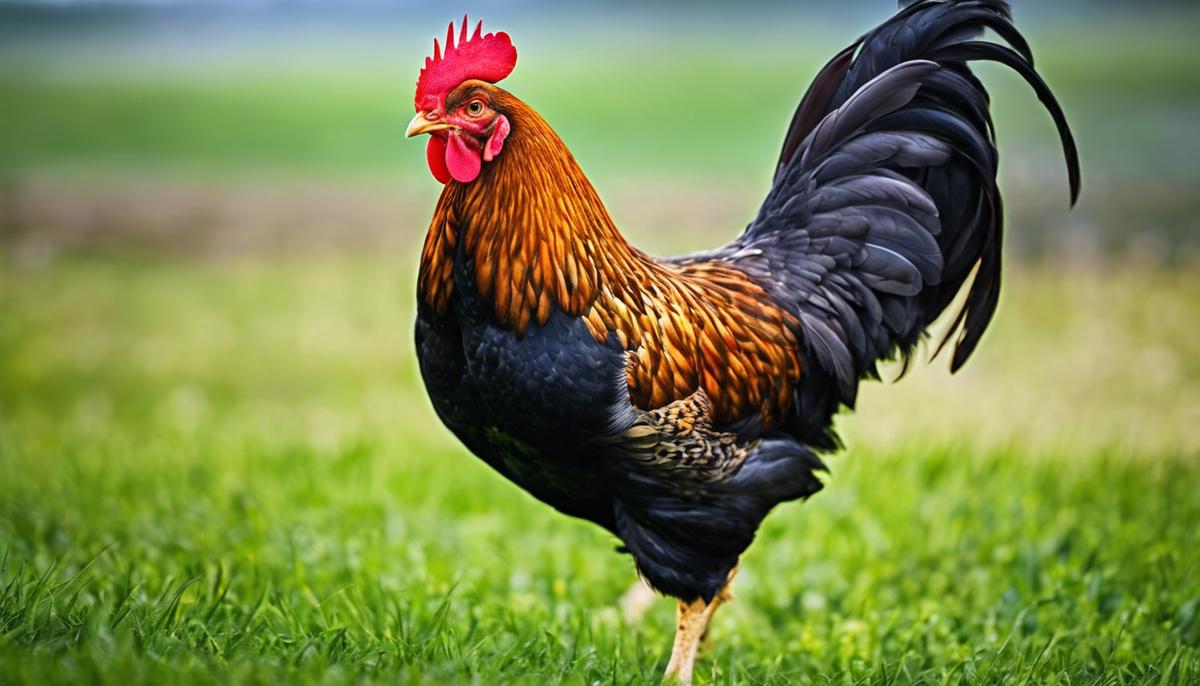

Agridisk
Egypt - Alexandria
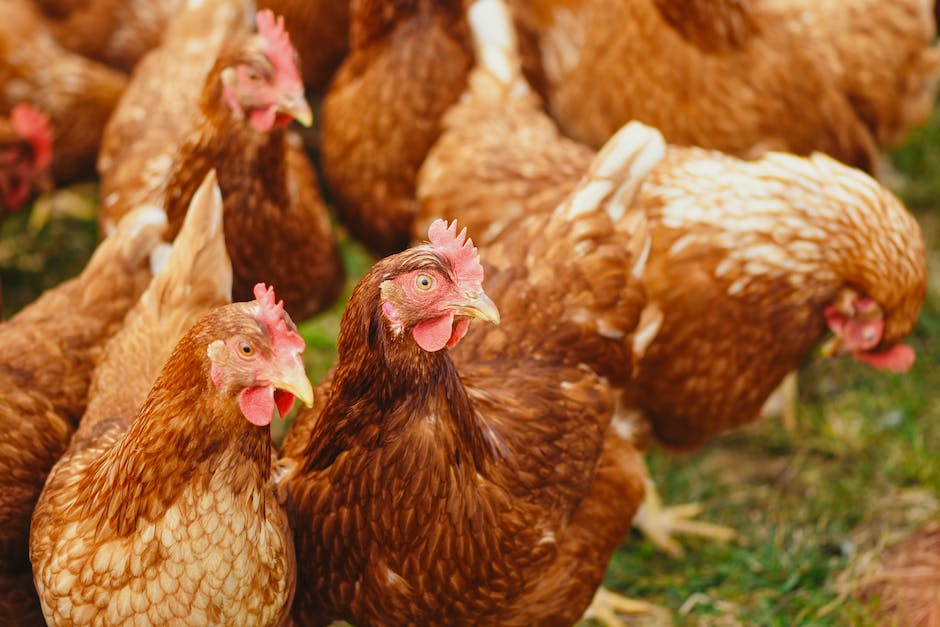
Chicken farm business & Chicken farm business plan
Description: The business of chicken farming is a dynamic, multifaceted industry that intricately balances consumer demands with cutting-edge innovations and environmental responsibilities. As a staple in diets across our nation, the poultry market is a reflection of evolving tastes, ethical considerations, and an ever-increasing desire for food transparency. In this essay, we'll dive into the market analysis and consumer demand that shape the poultry farming landscape, examine the technological advancements improving efficiency and productivity, and explore critical aspects of financial management that drive industry success. Additionally, we'll navigate the complex regulatory environment that governs poultry production and discuss the indispensable role of sustainable practices in maintaining both ecosystem health and corporate viability. In the dynamic world of agribusiness, poultry farming has evolved into a tour de force, and consumer demand has been at the heart of this transformation. Visionary entrepreneurs and incumbent industry magnates alike understand that to thrive in such a competitive market, one must decipher, anticipate, and adapt to the ever-changing appetite of the consumer base. Modern consumers are no longer passive entities; they are empowered protagonists in the agricultural narrative. Preferences for fresher, healthier, and more sustainable options have redefined the poultry landscape. Gone are the days of one-size-fits-all farming. Today's discerning buyer is the arbitrator of quality and the beacon that guides poultry production practices. Consider the push for organic and free-range poultry; this is not a market fad, it's a sea change driven by patrons opting for products aligned with higher welfare standards. The industry's response? A pivot towards more humane methods of farming, larger spaces for birds to roam, and feed that is free from antibiotics and growth hormones. This shift is not merely cosmetic; it is an overhaul of the supply chain, impacting everything from feed procurement to the marketing narratives on packages. Likewise, the clean eating trend has thrust transparency into the limelight. The modern-day consumer's palate prefers poultry that can be traced back to its origin. Farm-to-table isn't just a culinary buzzword; it's a requisite for farms aiming to command market share. Agribusinesses and retailers have had to perfect not only their rearing practices but also their storytelling prowess—connecting with the customer through the journey of the product. Then there's technology—an ally to consumer demand. Precision farming, drone technology, and data analytics have given poultry producers the tools to create hyper-efficient operations that meet consumer expectations. As a result, supply chains have become more responsive, capable of adjusting to fluctuations in demand with remarkable agility. However, agility is not the only trait required. Sustainability, once an idealistic pursuit, has become a business-critical strategy. The public's call for environmental accountability is steering the industry towards resource-efficient and lower-carbon-intensive practices. Poultry farms are now at the forefront of initiatives like renewable energy use, waste reduction, and water conservation. In closing, let's recognize that the contemporary landscape of poultry farming is a reflection of consumer demand—a manifestation of the choices, values, and voices of the market. Those at the cutting edge are reaping the rewards of listening and adapting, and they're not just responding; they're shaping consumer trends themselves. It's a symbiotic relationship where the market's pulse dictates the rhythm of production. In this high-stakes ballet of supply and demand, only those in tune with the desires of the consumer will lead the dance. In the fierce competition of the poultry industry, where every player is looking to carve out an edge, artificial intelligence stands as the transformative force charting the course towards futuristic farming. Cutting-edge innovations in AI not only streamline operations but also peer into the complexities of genetic selection to produce hardier and more efficient birds. Beyond the reach of conventional techniques, precision farming is taking poultry production by storm. By leveraging data analytics, farms are now optimizing conditions for each individual bird. Sensors abound monitor temperature, humidity, and CO2 levels, while advanced software adjusts environmental parameters in real time. The result? Healthier poultry, optimized feed utilization, and reduced mortality rates. Robotic technology in the poultry industry isn't a sci-fi pipe dream—it's today's reality. Sophisticated machines are being deployed for tasks ranging from feeding to egg collection, not just increasing efficiency but also improving conditions for the birds by reducing human contact and associated stress. Breakthroughs in CRISPR and gene editing technologies promise a future where disease resistance can be woven into the very DNA of poultry breeds. Coupled with real-time disease surveillance systems, this innovation can significantly curb the spread of disease, averting economic losses and safeguarding animal welfare. Absolute transparency for both producer and consumer is nearing grasp with blockchain technology. By offering an immutable ledger of the poultry supply chain, stakeholders have clear visibility from hatchery to table, reducing the risk of fraud and ensuring compliance with stringent health standards. These cutting-edge innovations are not mere incremental upgrades. They represent a leap forward into a new era of poultry production—one that responds deftly to consumer demands and anticipates tomorrow's challenges. The poultry industry pioneers harnessing these technologies today are the leaders shaping the future of sustainable and responsible farming. With operational costs presenting a persistent challenge, savvy budgeting becomes paramount. Each decision must be weighed against its financial implications—be it capital investments for equipment upgrades or securing competitively priced feed via strategic sourcing. A comprehensive understanding of cash flow analysis is indispensable for liquidity, allowing for timely investments into humane and efficient farming practices that align with market trends and regulatory shifts. Risk management takes flight in poultry farming when armed with sharp financial acumen. The volatile nature of commodity pricing, coupled with potential health epidemics that can decimate an entire flock, requires a shield of solid financial planning and appropriate insurance coverage. Diversifying revenue streams also plays a key role, whether through incorporating agrotourism or launching branded, value-added products to capture more of the consumer dollar. Furthermore, access to capital for farm expansion or modernization isn't just about knowing the right lenders—it's about presenting a risk-adjusted business case that demonstrates return on investment through rigorous financial projections. Only then can a farm scale sustainably without succumbing to the pressures of debt. The navigation of government subsidies and tax incentives is another domain where financial literacy is not optional. Understanding the implications of various compliance requirements and tax benefits can significantly impact a farm's bottom line. It allows farmers to capitalize on incentives designed for energy efficiency and sustainable practices—key areas that resonate with today's environmentally conscious consumer. Moreover, the integration of financial technologies (FinTech) streamlines operations, from automated payroll systems to sophisticated software for real-time financial reporting. Embracing these advancements is not a mere trend; it's a step towards future-proofing the financial health of the farm against the unpredictability of market forces. To conclude, in the pursuit of excellence in poultry farming, embracing comprehensive financial acumen is foundational. It ensures not just survival, but the thriving of a farm amidst the complexities of modern consumer demand and the evolving agricultural sector. With astute financial management as the backbone of a poultry business, the road to innovation and profitability is well-paved, allowing the farmer to soar high above potential pitfalls. It’s clear that when it comes to running a successful chicken farm, any entrepreneur worth their salt knows that every penny counts, and every financial decision plucked wisely can mean the difference between merely scratching the surface and truly taking flight. In the tightrope walk of chicken farming operations, regulations and compliance aren't merely hoops to jump through—they're the guardrails to industry success. Balancing on the regulatory beam is no small feat, as it directly influences operational efficiencies, product quality, and ultimately, the bottom line. Consider the influences of the USDA and FDA, whose regulations encompass everything from bird welfare to food safety. These guidelines ensure a level of quality that consumers trust, but they require stringent adherence that only the most attentive operators can consistently manage. Furthermore, the evolution of animal welfare laws further complicates this landscape, necessitating not just ethical considerations but significant alterations to housing and handling practices that can be costly. The omnipresence of environmental regulations continues to redefine operational protocols. From manure management, which must comply with the Environmental Protection Agency's (EPA) standards, to the discharge of water used in processing plants, these eco-centric rules play a pivotal role in a farm's operational focus, and noncompliance could lead to substantial fines and long-term reputational damage. Moreover, compliance affects international trade in a sector increasingly looking beyond domestic demand. Importing and exporting poultry products have become a regulatory chess game, where understanding and complying with the diverse rules of each market is crucial. The complexity of these global standards, including health certificates and sanitary measures, requires farms to stay vigilant and adaptable. In the realm of biosecurity, regulations demand proactive measures against avian influenza and other pathogens. Here, compliance isn't just a set of guidelines—it's a fortress protecting the industry's viability and consumer health. Staying ahead of potential outbreaks with effective biosecurity plans is no longer optional; it's a core component of industry stewardship. Let’s not overlook labor laws which, although vital for maintaining workforce standards, impose additional layers of protocol on farms. These include fair compensation, safe working conditions, and appropriate benefits that may impact operational costs and staffing models. In summary, the circuitry of compliance in chicken farming is complex, entrenched in every facet from feed to fork. It requires a robust understanding of both present laws and the foresight to prepare for future changes. As chicken farming operations expand and evolve, those who view regulations as a strategic advantage—rather than just a compliance cost—will find themselves leading the flock into a prosperous future. Regulations are the checks and balances that, when navigated expertly, yield not just a product that meets market demand but one that does so with integrity, sustainability, and profitability. Scaling any business demands more than a cursory glance at spreadsheets; it calls for an astute awareness of evolving industry landscapes. Nowhere is this more evident than in the realm of chicken farming, where sustainability is not merely an environmental buzzword but a robust lever of competitive advantage. The hidden gem in sustainable chicken farming lies in resilience. With climate change's unpredictable impacts, farms that operate at the mercy of nature's whims are relics of the past. Modern poultry establishments leverage sustainability to hedge against climatic volatility. This means more than being green; it's about ensuring business continuity when traditional farming methods falter. A sustainable framework paves the way for logistics optimization. A farm that produces its own renewable energy, for instance, isn't shackled by rising fuel prices or supply disruptions. Similarly, efficient waste management transforms a potential disposal cost into a revenue stream, be it through fertilizer sales or energy production. Moreover, lean manufacturing principles are finding a home in chicken farming. Waste is not just physical; it's every ounce of inefficiency that eats into margins. By designing systems that minimize resource usage while maximizing output – think precision feeding programs, water-saving technologies, and innovative housing designs – farms boost their bottom line and appeal to eco-conscious consumers. Regarding staffing, a commitment to sustainability attracts top-tier talent. In an era where employees seek out employers with values that resonate with their own, farms with a green ethos have a head-start in the war for labor. In the intricate dance of supply and demand, sustainability provides a reliable rhythm, seamlessly aligning with consumer preferences for ethically sourced products. This alignment not only caters to a market segment willing to pay a premium for such goods but also builds a brand reputation that can withstand the ebbing tides of market trends. Indeed, the true innovation in sustainable chicken farming is not any single technology or practice; it's the philosophy that integrates all aspects of operations into a cohesive, forward-thinking strategy. It is this very integration – this holistic approach – that fosters resilience, efficiency, and ethical production, securing chicken farming's viability in the market's future narrative. Entrepreneurs must realize that sustainability in chicken farming isn't just an optional strategy; it's a critical pivot point for industry leadership. As the market evolves, so must the approaches to poultry farming, ensuring that businesses not only survive but thrive in the face of emerging global challenges. As we have journeyed through the ins and outs of the chicken farm business, it's clear that this industry is not for the faint-hearted. It demands a comprehensive understanding of market demands, a willingness to invest in technological innovation, astuteness in financial planning, adherence to stringent regulations, and a deep commitment to sustainability. These core pillars are essential for current and aspiring poultry farmers aiming to carve out a successful niche in a competitive market. By embracing these challenges and opportunities with knowledge and foresight, the future of poultry farming can be as bright and robust as the communities it feeds. Ultimately, the fusion of technology, financial savvy, regulatory conformity, and green farming practices heralds a new era of agriculture – one that prioritizes profitability alongside planetary well-being. Chicken farming, a leading segment of agribusiness, invokes multifaceted pursuits including finance, marketing, compliance, and innovation. In this highly volatile and intensely competitive market, success primarily hinges upon sound knowledge of market dynamics, accurate financial forecasts, adherence to regulations, an innovative mindset, and ample risk mitigation. This essay transforms a cursory glance at the poultry industry into a seriously considered business prospect, providing a comprehensive business canvas for the public. The write-up elucidates the contemporary poultry market scenario, the salient features of a robust chicken farming business model, and cutting-edge technologies, while also assisting in navigating the regulatory landscape and managing potential risks. Businesses can be turbulent ecosystems, each with their unique set of challenges and opportunities. One of the most dynamic of these is the poultry market – ever-evolving, intricate, full of potential for growth yet unforgiving if not navigated appropriately. Having a clear understanding of this sector can yield immense benefits, offering unending opportunities for entrepreneurs at the cutting edge of innovation. Flocking to Opportunities Capital is, of course, crucial in the poultry industry. Investment in high-end technology automation promises improved efficiency, reduced labor costs, and increased production scales. To be at the forefront, businesses need to continuously invest in the latest tech advancements: automated feeders, mechanized egg collection systems, and more technologically advanced housing solutions. Those who have seized these tech-driven opportunities have often found themselves at the height of the market pecking order. The Chicken or the Egg? Market Trends Staying on top of trends plays a significant role in strategic planning. The battle of "meat vs. plant-based proteins" is hotter than ever. Is our audience leaning more towards vegetarian diets, or is chicken still a household favorite? React to these market shifts quickly, and it could be your golden egg moment. In addition, heightened attention is on poultry's environmental imprint. Taking pro-active, eco-friendly measures can position a brand as a sustainable choice for consumers. The green feathers will pay off as more consumers are becoming conscious shoppers, favoring those that align with their values. Nest-Egg: Building a Professional Network Cultivating a robust professional network in the poultry industry is indispensable. A strong network expands access to knowledge, capital, and industry insights – all integral for business competitiveness. Engaging in seminars, workshops, and joining relevant associations can help solidify a commanding presence within the industry. Making the Cluck Count Finally, always remember, in the poultry market, every strain matters. A keen eye for detail, precise planning, and swift decision-making bear the fruit of success in this field. By monitoring the health of the brood, ensuring the quality, and keeping track of the supply chain will help in maintaining a consistent growth path. In conclusion, understanding the poultry market's dynamics involves technology adoption, market trend adaptation, professional networking, detailed operation management, and more. Gaining this understanding is an entrepreneurial journey - a test of innovation, adaptability, and unfaltering tenacity. Navigate it well, and the dynamics of the poultry market can be a fount of prosperity for the savvy entrepreneur. Shop for prospects, peck at opportunities, and feather your cap with accomplishments as you soar in this field. Starting a chicken farm business isn't for the faint-hearted or the risk-averse - it requires grit, resilience, and astute business acumen. But with the outlined critical financial considerations and future projections, you can navigate the rough seas to reach your entrepreneurial vision. Capital expenditure forms a crucial part of your business' finance in the initial stages. From incurring costs for setting up chicken coops and brooders to purchasing hatchlings, feeds, vaccines, and the necessary equipment, these initial overheads can be substantial. Regarding finances, revolving loans for poultry farming, grants, and agriculture subsidies can be alternative funding sources to the traditional bank loans. Operationally, expenses in chicken farming are ongoing and run the gamut from feeding and healthcare costs to routine maintenance of the coop. Depending on the scale, labour costs can also impact profitability - a pitfall worth noting in your financial planning. To truly stand out in this business, quality is a non-negotiable attribute. Investing in healthy chicks and high-grade feed contributes to better-quality chickens and, by extension, more repeat buyers. Although it may result in higher initial expenditure, the ROI, in the long run, is significantly higher. Revenue projections are contingent on the market trends and your ability to penetrate those markets efficiently. Historically, the demand for poultry has remained steady, with occasional fluctuations due to health problems like avian flu. But on an optimistic note, as the world battles with the debates on meat versus plant-based proteins and focuses on sustainability, chicken - being a more eco-friendly protein option - continues to see an upward trend. In the pursuit of entrepreneurial success, being dynamic and adaptive plays a pivotal role. Understanding the interplay of demand-supply dynamics, dealing with market uncertainties, and manoeuvring across business cycles are the skills of the trade. Innovation forms the cornerstone of this predominately traditional industry. Utilizing technology for efficient farm management, selective breeding techniques, and marketing initiatives with a customer-centric approach can redefine success parameters in chicken farming. Lasty, an understated aspect is risk management. Poultry businesses aren't immune to factors such as diseases, sudden drop in chicken prices, or supply chain disruptions. Including a contingency plan within your financial considerations ensures you stay up and running. Long term projections reflect an optimistic outlook for the poultry farm industry with a projected Compound Annual Growth Rate (CAGR) of 3.4% from 2020 to 2027. A thorough understanding of the overall dynamics, coupled with meticulous attention to the minute details and strategic planning, can lead to an economically viable and successful chicken farming business - a solid platform for a promising entrepreneurial journey in poultry. Approaching the business of chicken farming requires thorough acumen and understanding of the regulatory context. Each entrepreneurial journey with poultry starts at the same starting line – acquiring knowledge about relevant regulations and guidelines from federal, state, and local authorities. In the U.S, the U.S Department of Agriculture (USDA) steers the ship for most poultry-related regulations. Beginning with the National Poultry Improvement Plan (NPIP), this federal-state-industry collaboration focuses on eliminating certain poultry diseases. A voluntary participation in NPIP can provide a chicken farm business a recognized health status, thus opening doors to the interstate and international trade. Socially conscious entrepreneurs would also want to pay heed to regulations focused on the welfare of chickens. Think about guidelines from the Animal and Plant Health Inspection Service (APHIS), outlining care standards for hatchlings right from the moment they are hatched until they are transported to farms. Dive into Occupational Safety and Health Administration (OSHA) standards if intending to house employees on your chicken farm. Ensuring worker safety isn't just ethical but also a legal obligation that can influence your business's reputation significantly. Environmental regulations cannot be missed when setting up a chicken farm business either. Implementing prudent waste management practices is crucial, governed by the Environmental Protection Agency's (EPA) regulations. Following these guidelines helps maintain a sustainable business that aligns with growing consumer demand for environmentally friendly businesses. For instance, negotiation and compliance with the Clean Water Act can oblige farms to acquire permits for discharge, influencing location and operational choices. Another pivotal regulation to consider lies within the food safety realm, namely, the Food Safety Modernization Act (FSMA) - a result of amplified consumer demand for higher quality foods. For chicken farmers, ensuring safety from farm to plate helps establish a strong brand image as a supplier of wholesome, healthy poultry. Capping it all, the zoning regulations at the state and local level play a decisive role in where the business can be set up. Each local government may have explicit ordinances in place dictating factors such as how close a chicken farm can be to populated areas. Diligently learning, interpreting, and applying the multitude of regulations to a chicken farm business not only sends a message of compliance but also symbolizes the responsibility one undertakes as a modern, forward-thinking business entity. Navigating the waters of the chicken farm business requires an entrepreneurial spirit that's willing to pivot with regulatory changes, adopt technology and innovation, and embrace dynamic market trends while putting ethics and responsibility at the forefront. Empower yourself with knowledge, be vigilant, and the road to poultry entrepreneurship would surely be a rewarding journey. Looking into the crystal ball of poultry farming, it becomes clear: advantage is within reach for those apt to tap into innovations and technology. As the industry hurdles forward, using emerging technology is no longer an option, but a necessity. This is the age of smart farms, where technology shapes the way we raise, process, and distribute poultry. Innovations such as Internet of Things (IoT) devices and sensors can revolutionize our approach to chicken farming. These devices gather real-time data on a plethora of factors that impact chicken health and productivity, such as temperature, humidity, and air quality. This wealth of information empowers farmers to make timely interventions, preserving bird health, and ultimately bolsters the farm's productivity and profitability. The role of Artificial Intelligence (AI) in chicken farming cannot be overemphasized. With advanced machinery learning, AI can streamline farm operations. One example is the selection process. AI can be trained to recognize and select chickens based on size and weight, saving farmers tremendous time and effort. Through machine learning and predictive analysis, AI applications can anticipate health problems in a flock, reducing costs of medication and minimizing losses. Indeed, drones are another innovative tool making waves in poultry farming. Drones boasting thermal imaging cameras can take constant temperature readings of a chicken house. Detecting temperature variations rarely perceptible by the human eye, these drones can spot sick birds long before traditional methods, enabling early treatment and preventing the spread of diseases. And who would have imagined that someday robots would amble among us? Robots employed in poultry farms can automate a myriad of tasks which falter under human hands. From automating feeding schedules to cleaning communal areas, robots provide consistency, speed, and accuracy--factors critical to any successful poultry farm. Using robots to accomplish these routine yet vital tasks frees up personnel to focus on more complex tasks, transforming traditional chicken farming methods. Why limit one's reach to local markets when the world is a click away? Digital marketing tools such as social media and search engine optimization can catapult a chicken farm business onto the world stage. These tools help attract new customers, retain old ones, and build brand loyalty, breeding new opportunities for business expansion. Furthermore, the power of blockchain technology should not be undermined. This technology lends transparency and traceability to the supply chain, reassuring consumers of the authenticity and rightful practices of the poultry products they consume. Success is at the fingertips of those who can attune to these consumer demands. Finally, big data analytics can drive strategic decisions in any poultry farming business. Utilizing real-time data, one can make informed decisions on everything from feed optimization to capacity planning and disease management. Implementing these methods can certainly dial up optimization and profitability. Embracing innovations and technology allows the poultry industry to thrive even amidst challenges. The industry stands at the dawn of exponential advancements, unraveled by those who dare to unearth. The entrepreneurial spirit is about seeing the potential of tomorrow and bringing it to life, today. This is your call to action; seize the day, leverage the technology, and redefine the boundaries of what's achievable in the world of chicken farming. Delving into the risks faced in the chicken farming business can be a daunting task, but it is the lifeblood for survival and growth in this dynamic industry. Knowing what issues might arise and having a strategy to counter them enhances not only the stability of the business, but also its ability to make waves in the entrepreneurial world. Here are some of the key risks faced by a chicken farm business and strategies to counteract them. The volatility of feed and supply costs is a significant risk faced by chicken farmers. With varying prices of grains and other feed components, the farm's operational costs can skyrocket and potentially dent profit margins. As a strategy to counteract this, it's critical to engage supply chain management procedures, contract negotiations, or even forward buying of feedstock when the prices are low. These proactive steps can manage and control feed costs to a reasonable level. Poultry diseases pose an unpredicted risk that requires strategical planning and careful attention. Devastation from diseases like Avian Influenza is potential in chicken farming. Building a robust biosecurity strategy, vaccinating the birds regularly, ensuring clean environments, and having a stringent disease monitoring system can help control the risk of illness outbreak. Further, changes in consumer demand play a significant role. With evolving trends, consumer behavior may lean more towards organic, free-range, or alternative products, which could affect the demand for conventional chicken meat. To counteract this, diversifying the product line and investing in market research will be paramount for capturing current market trends and predicting future ones. Legislative and environmental regulations also pose a considerable risk. Standards regarding animal welfare, environmental laws, and worker safety can change, impacting the way the farm operates. Building a culture of adaptability, learning, and compliance is the only way to contend with these risks. Moreover, staying abreast of regulatory changes, engaging in professional networks, and bridging a strong relationship with local agency officials can pave the way to a more proactive approach. Finally, high operational costs leading to low profitability can be a risk for chicken farming. Leveraging technology for automation or streamlining farm management can significantly reduce these expenditures. Furthermore, the right approach towards marketing and sales strategies has an outsized effect on revenue growth. As the business landscape becomes more volatile, the smartest strategy for an entrepreneur is to be prepared. Adapting to risks and turning them into opportunities for growth is the way forward in the business journey. From each risk, there is a lesson to be learned and a strategy to be developed to pave the path to business domination. Remember, every challenge is merely an opportunity in disguise, awaiting the right strategy to conquer it. With potential challenges scattered across the industry, chicken farming businesses must perpetually swim against the current, adjusting sails based on market wind and regulatory waves, to reach the shores of success. A well-thought-out risk management framework and contingency planning remain at the heart of this sustainability. Concurrently, businesses should keep an eagle eye on innovation, incorporating game-changing technologies as a scheme for enhancement. Equipped with this array of information, prospective entrepreneurs and established businesses alike can chart a trajectory of growth, profitability, and resilience in the chicken farming industry, stimulating economic benefits as well as contributing to an efficiently fed world.Chicken farm business & Chicken farm business plan
Chicken farm business
Market Analysis and Consumer Demand
The Undeniable Influence of Consumer Demand on Poultry Farming

Technological Innovations in Poultry Farming
Harnessing Artificial Intelligence to Revolutionize Poultry Production
Precision Farming - The New Frontier of Poultry Efficiency
Embracing Robotics for Improved Welfare and Operational Efficiency
Disease Surveillance with Genome Editing: A Proactive Approach
Incorporating Blockchain for Undisputable Traceability

Financial Management and Funding | Chicken farm business
In the fast-paced world of poultry farming, understanding the intricate web of financial acumen is not just an advantage—it's a necessity. It's crucial for the modern poultry farmer to master the balance sheet as well as they manage their broods. Financial prowess enables farmers to forecast, monitor, and respond to the ever-shifting economic landscape, ensuring that profitability doesn't slip through the cracks like so much feed on a barn floor.
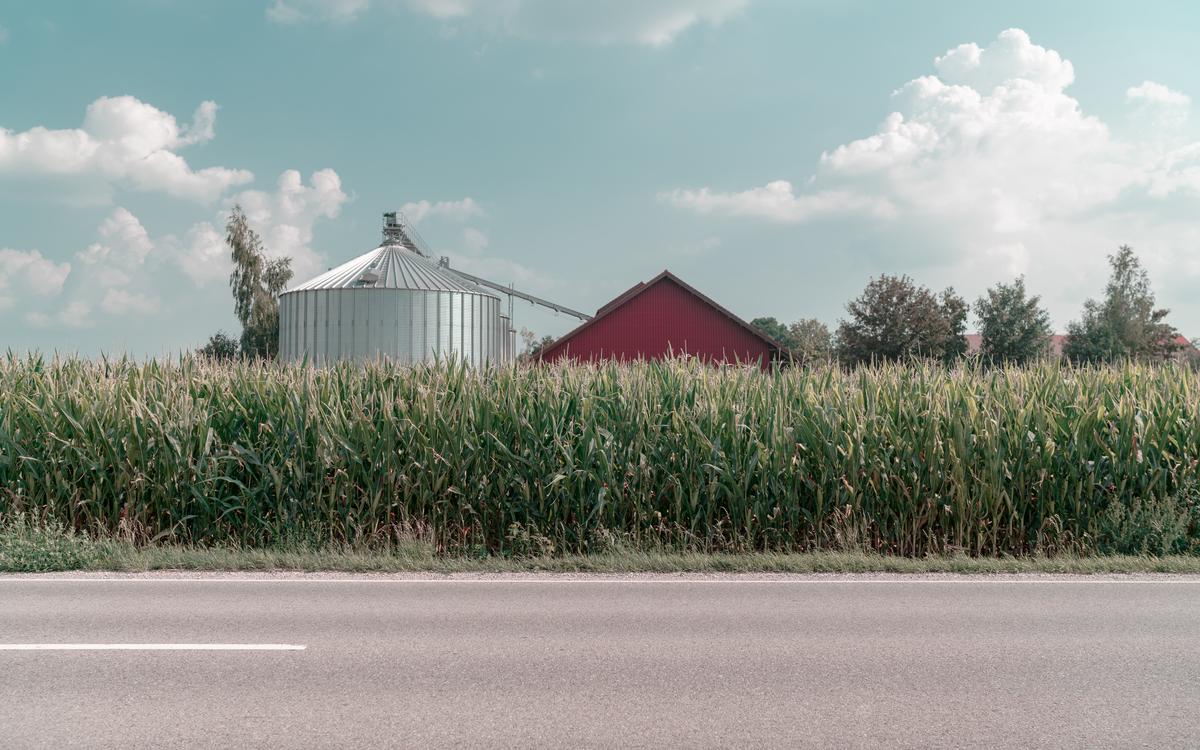
Regulations and Compliance in Poultry Farming
Navigating the Compliance Labyrinth: The Regulatory Impact on Chicken Farming Operations

Sustainable Practices and Environmental Responsibility | Chicken farm business
Why Are Sustainable Practices a Game-Changer in Chicken Farming?

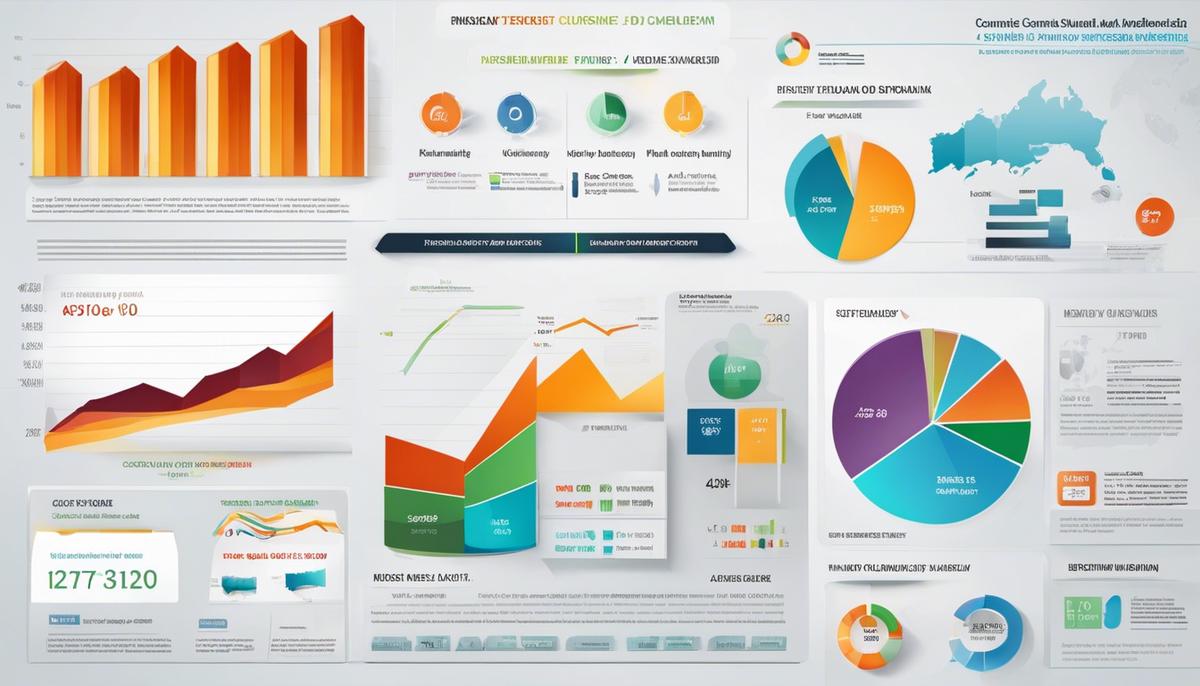
Chicken farm business plan
Understanding Market Dynamics | Chicken farm business plan

Investment and Financial Projections | Chicken farm business plan
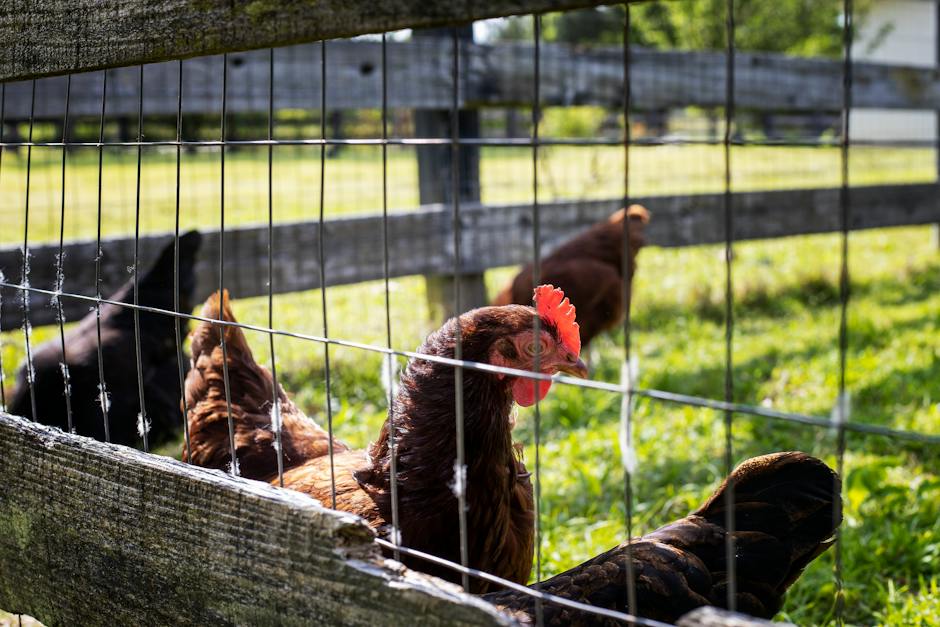
Regulations and Compliance | Chicken farm business plan
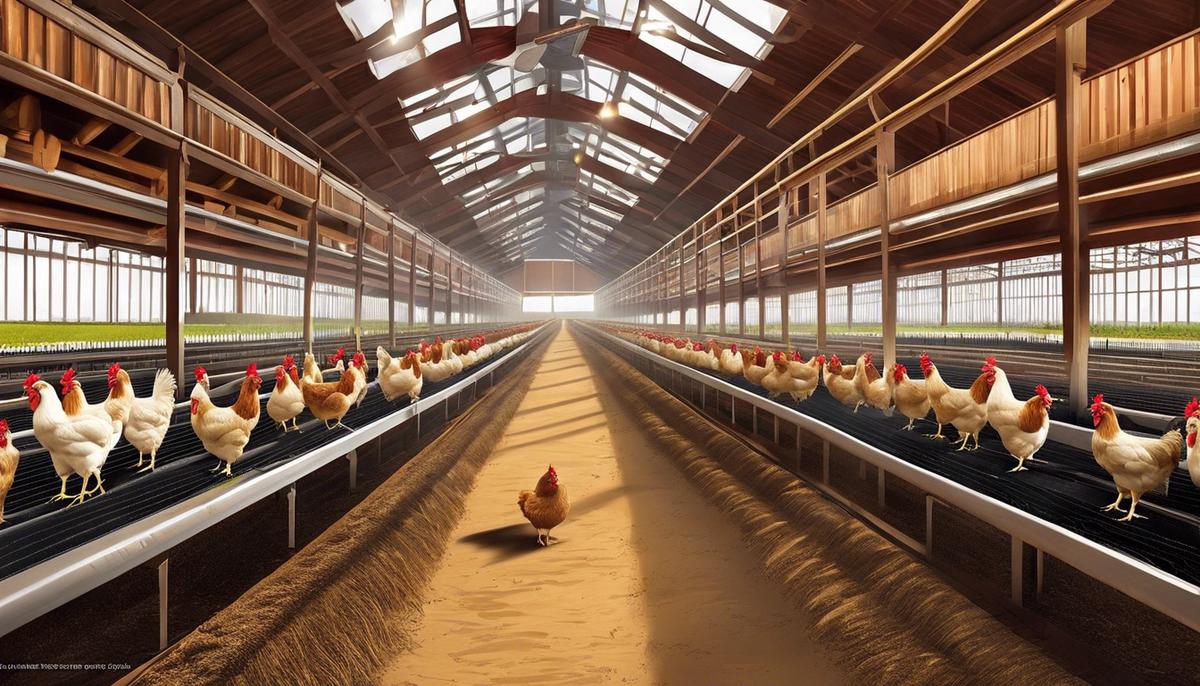
Innovations and Technology in Poultry Farming
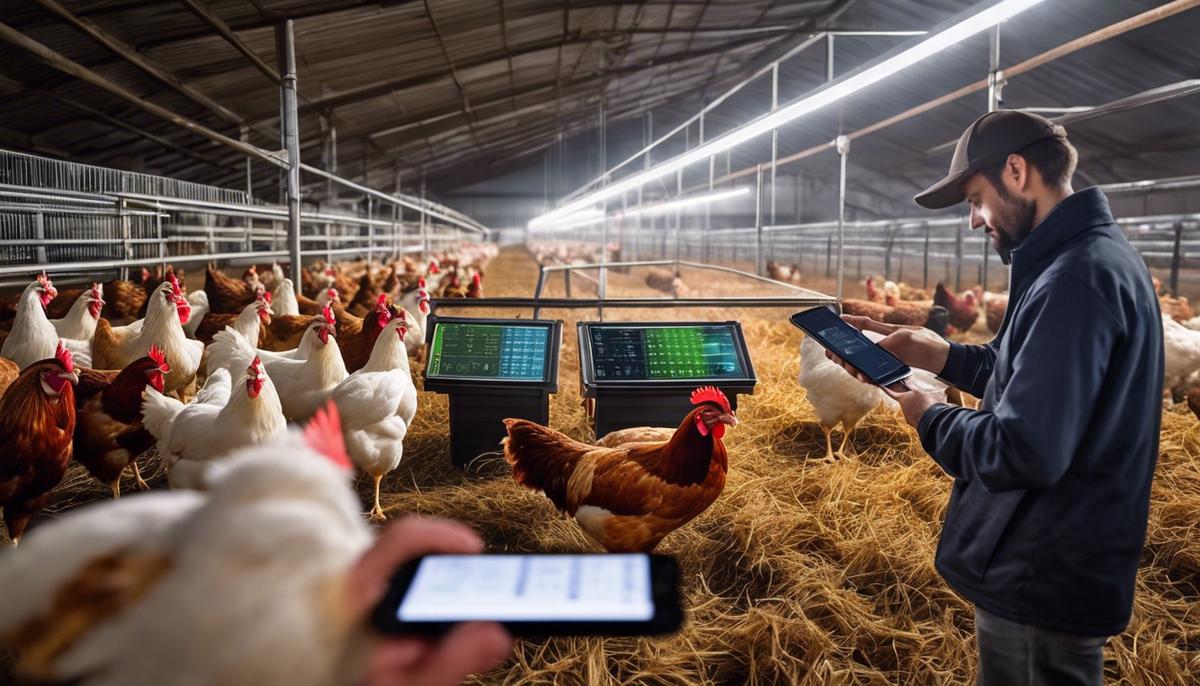
Risk Management and Contingency Planning | Chicken farm business plan
